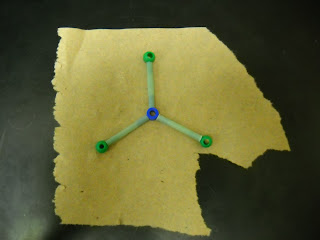 Introduction:
Introduction:In our lab we try and show the use of the percent yield formulas and how they can be useful in a lab situation. We use the formulas to figure out how much of the copper we will get out of the solution of Copper II Sulfate Pentahydrate and Aluminum flakes. Its very a effective way of figuring out how much is produced considering that the whole class is not going to have the same exact measurements meaning there are gonna be several different answers and equations threw out the whole class. This is a help yourself and a learn it yourself type of lab meaning you'll probably remember it a lot better then if your instructor were to stand in front of you and do it all for you.
The reaction taking place in this lab is a Single displacement reaction, due to the Copper sulfate being changed by the Aluminum flakes and the water turning the once blue flakes of Copper Sulfate into that copper color we see all the time on the ground facing heads up I hope. The percent yield is to show how much leeway you have in a lab to mess up or how much other people will mess up. The activities series is a very valuable tool in this lab, it aids to predicting the products of replacement reactions.
Purpose:
To determine the number of grams of copper that will be produced from an oxidation reduction reaction when you know the mass of Aluminum that reacted with a known amount of copper II sulfate pentahydrate and to compare this to the actual yield of copper. Also to determine the percent yield of Copper II Sulfate Pentahydrate by determining the theoretical percent yield.
Materials and Setup:
You will obtain a measured sample if aluminum foil and a measured amount of copper sulfate pentahydrate. You will then react the two in a n aqueous medium within a medium sized beaker: stirring frequently. You wi
 ll filter, dry, and weigh the resulting product.
ll filter, dry, and weigh the resulting product.Procedure:
1. Obtain a medium sized( 250 to 400 ml) beaker.
2. add 75 to 100 ml of water to beaker: set-up apparatus to heat your mixture over a Bunsen burner to begin heating.
3. measure out about 15g of Copper (II) sulfate pentrahydrate (CuSo4* 5H2O) and record the mass in the data table. Then slowly add the crystals to the heating water.
 Safety:
Safety:In this lab safety is a big issue considering you are working with a Bunsen burner and potentially hazardous chemicals. So you should wear the proper safety gear, such as: Goggles, aprons, gloves and make sure that your instructor is in the room just in case something crazy like and explosion happens. Make sure you know where all the First Aid kits are and make sure that you know how to use the eye washer and shower stations just in case you get some of the chemicals explode on to you or your eyes.Also be aware where your fire blanket is in the room since we are dealing with fire. Be sure that if there is any broken glass to put it into the the designated area in your class room. We'd rather no one lose and eye during this product.
During Procedure:
During this procedure we used various amounts of lab equipment to make sure that it was a safe fun lab! During you need to make sure that you are taking notes on some of the variables that are subject to change such as the amount of copper used or aluminum flakes this is very important (reason for putting it twice).
Making a Table:
You need to make a table during this to make sure that you have all the information that you need down (yet again). ITs very Important! also balanced equations would help you in making a table....But be sure to double check your equation so you dont look silly for getting it wrong. If you have any issues in solving the problem go to your instructor and see if he is willing to save your poor soul:]. I would have provided my table in for demonstration purposes but sadly it was drenched in water and became impossible to read and I don't want to do the lab allllllll over again. Sorry for the inconvenience. P.s. its very important to make sure that all partners just for this rare occasion copy or write the table as well, just that if your paper is completely submerged in water because babies think thats funny, don't make the team completely screwed.
Conclusion:
Your end product for this lab is a copper tented mass at the bottom of your funnel, measure how much it weighs and the use a percent yield equation to figure how far off you were from the theoretical yield. When you have completed this put that information into the table and then your all done! You have now successfully completed the lab and you can now go rub it in your teachers face cause you did it by your self right? Well you better have, considering that it was actually a fairly easy lab:) but its ok to ask for help. When you are all done you can look back and remember how easy it was to do theoretical and percent yield equations, how balanced equations are useful in this lab, how figuring out the reaction before hand in your balanced equation is a way to better discuss and help you realize how cool it was too see it happen. IN conclusion you learned sooooooo much hopefully.















